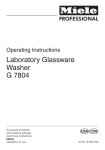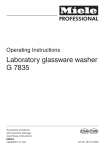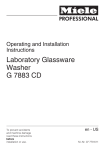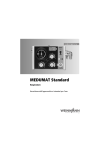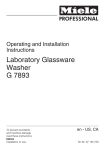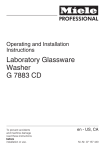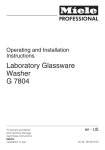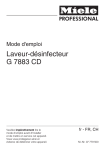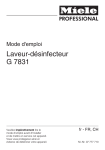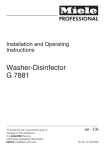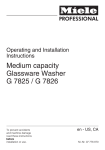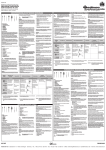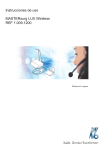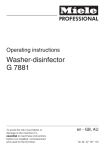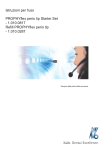Download Miele G 7883 Washer User Manual
Transcript
Operating Instructions Laboratory Glassware Washer G 7883 To prevent accidents and machine damage read these instructions before installation or use. UV M.-Nr. 05 893 860 Contents IMPORTANT SAFETY INSTRUCTIONS . . . . . . . . . . . . . . . . . . . . . . . . . . . . . . . . . 3 Description of the machine . . . . . . . . . . . . . . . . . . . . . . . . . . . . . . . . . . . . . . . . . . 7 Guide to the lab washer . . . . . . . . . . . . . . . . . . . . . . . . . . . . . . . . . . . . . . . . . . . . 8 Opening and closing the door . . . . . . . . . . . . . . . . . . . . . . . . . . . . . . . . . . . . . . 10 Water softener . . . . . . . . . . . . . . . . . . . . . . . . . . . . . . . . . . . . . . . . . . . . . . . . . . . 12 Setting the water softener . . . . . . . . . . . . . . . . . . . . . . . . . . . . . . . . . . . . . . . . . . . 14 Filling the salt reservoir . . . . . . . . . . . . . . . . . . . . . . . . . . . . . . . . . . . . . . . . . . . . . 15 Salt indicator . . . . . . . . . . . . . . . . . . . . . . . . . . . . . . . . . . . . . . . . . . . . . . . . . . . . . 16 Adding rinse aid . . . . . . . . . . . . . . . . . . . . . . . . . . . . . . . . . . . . . . . . . . . . . . . . . . 17 Setting the rinse aid dosage . . . . . . . . . . . . . . . . . . . . . . . . . . . . . . . . . . . . . . . . . 18 Adding neutralizing agent . . . . . . . . . . . . . . . . . . . . . . . . . . . . . . . . . . . . . . . . . . 19 Adding detergent . . . . . . . . . . . . . . . . . . . . . . . . . . . . . . . . . . . . . . . . . . . . . . . . . 22 Loading . . . . . . . . . . . . . . . . . . . . . . . . . . . . . . . . . . . . . . . . . . . . . . . . . . . . . . . . . 24 Adjusting the upper basket . . . . . . . . . . . . . . . . . . . . . . . . . . . . . . . . . . . . . . . . . . 28 Program guide . . . . . . . . . . . . . . . . . . . . . . . . . . . . . . . . . . . . . . . . . . . . . . . . . . . 29 Operation . . . . . . . . . . . . . . . . . . . . . . . . . . . . . . . . . . . . . . . . . . . . . . . . . . . . . . . 31 Turning on . . . . . . . . . . . . . . . . . . . . . . . . . . . . . . . . . . . . . . . . . . . . . . . . . . . . . . . 31 Starting a program . . . . . . . . . . . . . . . . . . . . . . . . . . . . . . . . . . . . . . . . . . . . . . . . . 31 Drying . . . . . . . . . . . . . . . . . . . . . . . . . . . . . . . . . . . . . . . . . . . . . . . . . . . . . . . . . . 32 Changing a program . . . . . . . . . . . . . . . . . . . . . . . . . . . . . . . . . . . . . . . . . . . . . . . 32 At the end of a program. . . . . . . . . . . . . . . . . . . . . . . . . . . . . . . . . . . . . . . . . . . . . 32 Turning off . . . . . . . . . . . . . . . . . . . . . . . . . . . . . . . . . . . . . . . . . . . . . . . . . . . . . . . 32 Canceling a program . . . . . . . . . . . . . . . . . . . . . . . . . . . . . . . . . . . . . . . . . . . . . . . 33 Programming special functions . . . . . . . . . . . . . . . . . . . . . . . . . . . . . . . . . . . . . 34 Machine care . . . . . . . . . . . . . . . . . . . . . . . . . . . . . . . . . . . . . . . . . . . . . . . . . . . . 43 Trouble shooting . . . . . . . . . . . . . . . . . . . . . . . . . . . . . . . . . . . . . . . . . . . . . . . . . 46 After Sales Service . . . . . . . . . . . . . . . . . . . . . . . . . . . . . . . . . . . . . . . . . . . . . . . 49 Caring for the environment . . . . . . . . . . . . . . . . . . . . . . . . . . . . . . . . . . . . . . . . . 52 Installation . . . . . . . . . . . . . . . . . . . . . . . . . . . . . . . . . . . . . . . . . . . . . . . . . . . . . . 53 Plumbing. . . . . . . . . . . . . . . . . . . . . . . . . . . . . . . . . . . . . . . . . . . . . . . . . . . . . . . . 55 Water inlet . . . . . . . . . . . . . . . . . . . . . . . . . . . . . . . . . . . . . . . . . . . . . . . . . . . . . . . 55 Electrical connection . . . . . . . . . . . . . . . . . . . . . . . . . . . . . . . . . . . . . . . . . . . . . . 58 Technical data . . . . . . . . . . . . . . . . . . . . . . . . . . . . . . . . . . . . . . . . . . . . . . . . . . . 60 2 IMPORTANT SAFETY INSTRUCTIONS Installation and Service This appliance is only intended for specialized applications. Only use the appliance for its intended purpose. Any other use, conversion or modification is dangerous. The manufacturer cannot be held responsible for damages caused by improper use of this machine. This appliance complies with current safety requirements. Improper use of the appliance can lead to personal injury and material damage. Read all instructions before installing or using this appliance. Keep these operating instructions in a safe place and pass them on to any future user. The machine should only be installed, maintained and repaired by a Miele authorized service technician. Repairs by unqualified persons could be dangerous. Do not install the machine in an area where a danger of explosion or freezing may be present. Be certain this appliance is properly installed and grounded by an authorized technician. To guarantee the electrical safety of this appliance, continuity must exist between the appliance and an effective grounding system. It is imperative that this basic safety requirement be met. If there is any doubt, have the electrical system of the building checked by a qualified technician. The manufacturer cannot be held responsible for damage or injury caused by the lack of or inadequacy of an effective grounding system. A damaged machine is dangerous; turn off the machine at the main power supply immediately and call the Miele Technical Service Department. Before servicing, disconnect the power supply by either removing the fuse or "tripping" the circuit breaker. 3 IMPORTANT SAFETY INSTRUCTIONS Use Personnel operating the machine should be trained regularly. Children and untrained personnel must not be allowed access to the machine or its controls. BURN AND SCALD HAZARD This washer reaches very high temperatures. Take care when unloading the unit. Let baskets and inserts cool before touching them. Any water which may remain in containers will be very hot and must be emptied into the wash cabinet. BURN HAZARD The heating elements become extremely hot during use. Do not touch the heating elements during or directly after the end of a program. Take care when handling liquids such as detergents, wetting agents or neutralizing agents. These may contain irritating or corrosive ingredients. Do not use an organic solvent in this washer, as an explosion may occur. Wear protective gloves and goggles. The manufacturer’s safety conditions must be observed for all chemical agents. 4 Avoid inhaling powdered detergent. If swallowed, it can cause burning in the mouth and throat or inhibit breathing. Be careful when sorting items with sharp pointed ends. If possible, place the pointed end downwards. The water in the machine must not be used as drinking water. Do not sit or lean on the open door. Injury or machine damage could result. Never use a water hose or a high pressure hose to clean the machine or the areas surrounding it. Only use cleaning agents formulated for special processes and approved by Miele for use with this machine. Use of unsuitable cleaning agents could adversely affect the components of the machine. IMPORTANT SAFETY INSTRUCTIONS Pre-treatments with cleaning or disinfecting agents can create suds, as can certain rinsing agents. For pre-treatment and / or cleaning, only use low-sudsing detergents and disinfecting agents which have been approved by Miele. Suds can have an adverse effect on the cleaning process. When a chemical additive is recommended on technical application grounds (for example, with a cleaning agent), this does not imply that the manufacturer of the machine takes responsibility for the effect of the chemical on the material of the items being cleaned. Please be aware that changes in formulation, storage conditions, etc, which may not be published by the chemical producer, can have a negative effect on the cleaning result. When using cleaning agents and specialized products, it is essential that the manufacturer’s instructions are followed. Only use the product for the application described by the manufacturer to avoid any material damage or the occurrence of strong chemical reactions. The machine is designed only for operation with water and additive cleaning agents. Organic solvents must not be used in the machine. An explosion or machine corrosion could occur with the use of organic solvents. In critical applications where very exact requirements must be met, it is highly recommended that all the relevant factors for the process, such as cleaning agent, quality of water, etc., are discussed with Miele’s Application Specialist. The mobile units and special inserts should only be used for their specific applications. Empty any containers or utensils before arranging them in the machine. Do not allow any remains of acids or solvents, particularly hydrochloric acid or chloride solutions, to get into the wash cabinet. The presence of any solvents should be minimized. To prevent corrosion damage, ensure that solutions or steam containing hydrochloric acid do not come into contact with the steel outer casing of the machine. 5 IMPORTANT SAFETY INSTRUCTIONS Accessories Only genuine Miele parts or accessories should be used with the Laboratory Glassware washer. The performance and safety of non-genuine parts or accessories cannot be guaranteed, and use of such parts or items may void the machine warranty. If you have specific questions about machine options or accessories, please call Miele. Disposal of an appliance When discarding a lab washer, disconnect it from the power supply, remove the door to the wash cabinet and cut off the power cord. For environmental and safety reasons, ensure the machine is completely drained of any residual water and cleaning agent. (Observe safety regulations and wear safety goggles and gloves). Make appropriate arrangements for the safe disposal of the machine. SAVE THESE INSTRUCTIONS 6 Description of the machine The G 7883 is the "industry standard" undercounter washer designed to handle the vast majority of glassware cleaning applications. 7 Guide to the lab washer a "On/Off" button j "Add liquid detergent" indicator * b "Door" button k "Add rinse aid" indicator c Display l "Add neutralizing agent" indicator d "Display" indicator m "Recharge Softener" indicator e "Drying" indicator n "Check fill/drain" indicator f "Start" indicator o Program sequence display g "Start" button p Program selector h "Drying" button * (only with optional DOS-Module) i "Display" button (toggles between the elapsed time, active wash blocks and actual temperature displays) 8 Guide to the lab washer a Connection for optional DOS-Module d Powdered detergent dispenser b Filter combination e Rinse aid reservoir (with dosage selector) c Salt reservoir (water softener) f Rinse aid level indicators 9 Opening and closing the door Electric door lock To cancel a program The machine is equipped with an electric door lock. The door can only be opened when the electrical supply to the machine is turned on, and the "On/Off" button is pressed. If a program has to be canceled in an emergency, e.g. the program has been interrupted due to a fault, the door will have to be opened manually. To open the door ^ Press the "Door" button in as far as it will go. At the same time, grip the handle and open the door. After the first intake of water, the door remains locked and cannot be opened until the end of the program (except during the "Rinse" and "Drain" programs). The machine can be programmed to open during the "Drying" program, if desired. Do not touch the heating elements. They remain hot for some time after the end of the program and can cause burns. To close the door ^ Lift the door upwards and push it until it clicks shut. Do not press the release catch while shutting the door. 10 ^ Turn the program selector to the "Stop" f position. The program is canceled after approximately 2 seconds. Opening and closing the door To open the door with the emergency release The emergency release should only be used when the door cannot be opened normally, e.g. in the event of a power failure. ^ Turn the program selector to "Stop" f. ^ Press the "On/Off" button to turn the machine off. ^ Take precaution against pressure wave release (rapid opening of the door). ^ Pull the emergency release cable (located at the bottom of the machine behind the service panel) downwards to open the door. The door latch will reset after the emergency cable has been activated. 11 Water softener Before using the machine for the first time, the water softener should be programmed. The water needs to be softened to avoid calcium deposit buildup on the items being cleaned and in the machine itself. To ensure a steady supply of soft water: 1. Make sure the water softener is programmed correctly. The softener contains settings from 1 - 60 gr/gal or 20 - 1080 ppm. 2. The salt reservoir must be filled with reactivation salt. (If the water hardness level is below 4 gr/gal [70 ppm]), the reservoir does not need to be filled.) The machine is set at the factory for a water hardness level of 19 gr/gal (340 ppm). 12 Your local water authority will advise you on the water hardness in your area. If the water supply is harder or softer than the factory setting (including below 4 gr/gal or 70 ppm), the setting will need to be changed. See "Setting the water softener". Water softener Settings Settings 1 - 30 gr/gal 1 - 30 ppm CaCO3 Settings 31 - 60 gr/gal 31 - 60 ppm CaCO3 1 2 3 4 5 6 7 8 9 10 11 12 13 14 15 16 17 18 19 20 21 22 23 24 25 26 27 28 29 30 1 2 3 4 5 6 7 8 9 10 11 12 13 14 15 16 17 18 19 *) 20 21 22 23 24 25 26 27 28 29 30 20 40 50 70 90 110 130 140 160 180 200 220 230 250 270 290 310 320 340 360 380 400 410 430 450 470 490 500 520 540 31 32 33 34 35 36 37 38 39 40 41 42 43 44 45 46 47 48 49 50 51 52 53 54 55 56 57 58 59 60 31 32 33 34 35 36 37 38 39 40 41 42 43 44 45 46 47 48 49 50 51 52 53 54 55 56 57 58 59 60 560 580 590 610 630 650 670 680 700 720 740 760 770 790 810 830 850 860 880 900 920 940 950 970 990 1010 1030 1040 1060 1080 *) factory setting 13 Water softener Setting the water softener ^ Turn off the machine with the "On/Off" button. ^ Turn the program selector to the "Stop" f position. ^ Press and hold the "Start" 6 and "Display" ß buttons at the same time. Turn the machine on with the "On/Off" button. The current program status "P..." will appear in the display. The "Fill/Drain" indicator will illuminate. The first time the water softener is set the "Recharge Softener" light will illuminate. This light will also illuminate after restoring the factory settings, see "Programming special functions". ^ Press the "Drying" 0 button once. "E01" (programming level 1) will appear in the display. ^ Turn the program selector one switch position clockwise (1 o’clock position). The number "19" will appear in the display (this indicates the factory water hardness setting in gr/gal, equivalent to 340 ppm). ^ Press the "Display" ß button as many times as necessary, or hold it in until the required value (hardness level in gr/gal) appears in the display. Once the number "60" has been reached, the counter will begin again at "0". ^ Press the "Start" 6 button. "SP" will appear in the display. ^ Press the "Start" 6 button again. 14 The setting will now be stored in memory. The display will go out. For future servicing, it is useful to make a note of your water hardness level. ^ Enter your water hardness level here: gr/gal or ppm ^ If your water is already soft and you would like to deactivate the water softener, set the hardness setting to "0". Water softener Filling the salt reservoir Only special, coarse-grained reactivation salt* should be used in this machine. *Available from Miele’s Professional Customer Service Department. Please see back page for more information. Do not use other types of salt, e.g. table salt, agricultural or gritting salt. These could contain components which are insoluble in water and could damage the water softener. If in doubt, consult Miele’s Professional Department. The salt reservoir holds approx. 2.5 kg of salt. ,Inadvertently filling the salt reservoir with detergent will damage the water softener. Before filling, make sure that you are using reactivation salt. ^ Remove the bottom basket from the machine. ^ Unscrew the salt reservoir cap. ^ Place the funnel provided in place. ^ Carefully fill the reservoir with salt. Displaced water will run out as it is being filled. ^ Wipe any residual salt off the screw threads on the socket. ^ Screw the cap on firmly. ^ Immediately after this step: Run the "Rinse" program to remove any traces of salt from the cabinet. Note: There may be a delay before the "Rinse" program starts due to the reactivation of the water softener. Before filling the salt reservoir with reactivation salt for the first time fill it with approx. 2.5 liters of water. 15 Water softener Salt indicator When the salt reservoir is empty the "Recharge Softener" indicator, b, illuminates to remind you to fill the reservoir. Reactivation takes place automatically during a program. The "Recharging" indicator, a, illuminates while this is occurring. 16 Adding rinse aid Rinse aid is not used in laboratory glassware cleaning applications. If rinse aid is required, the rinse aid dosage must be activated with assistance from Miele Technical Service. Rinse aid (e.g. Mielclear) is filled in the storage container and dispensed automatically. The storage reservoir holds about 180 ml. ,Inadvertently filling the storage ^ Unscrew the cap. reservoir with detergent will damage the reservoir. Be sure only to use rinse aid in the reservoir. ^ Pour rinse aid into the storage container until the level indicator is dark (see arrow in the illustration). Use a funnel if necessary. ^ If the "Add Rinse aid" indicator illuminates, the rinse aid storage container needs to be refilled. The storage container has a level indicator on the interior of the door. ^ Open the door. ^ Replace and tighten the cap. Clean up any spilled rinse aid to prevent oversudsing in the next wash. ^ Wait until the "Rinse" indicator on the control panel illuminates before adding any more rinse aid. 17 Adding rinse aid Setting the rinse aid dosage The dosage adjuster (see arrow in the illustration) in the opening has settings adjustable from 1 to 6 (1 - 6 ml). It is preset to "3" (3 ml). ^ Use a flat headed screwdriver to turn the dial to the correct setting. If spots remain on the items, use a higher setting. If smearing or cloudy streaks appear, use a lower setting. 18 Adding neutralizing agent Neutralizer (pH-level: acidic) neutralizes detergent residue on the surface of glassware and other items being cleaned. It is automatically dispensed in the rinse following the wash step of a program. The relevant program (see "Program Guide" - DOS 3) cannot be started until the dispensing system has been primed. (This function can only be canceled by a Miele Service Engineer.) ^ Place the container of neutralizer (red) next to the machine. ^ Insert the siphon tube into the container (observe the color code). Setting the dosage and priming the dispensing system ^ See "Programming special functions". Important The container should not be allowed to empty completely. When the "Add neutralizer" indicator illuminates: 19 Adding neutralizing agent Setting the neutralizer dosage and priming the neutralizer dispensing system First you need to access the programming mode: To access the programming mode ^ Turn the program selector to "Stop" f. ^ Turn the machine off. ^ Press and hold the "Display" ß and "Start" 6 button. At the same time turn the lab washer on by the main switch I-0. The display shows the current program status "P...". The Fill/Drain indicator lights. ^ Press the "Drying" 0 button twice. "E02" (programming level 2) appears in the display. The dosage is factory set to 0.10, you may or may not be required to adjust it. Set the dosage concentration according to the detergent manufacturer’s recommendations. Example: The manufacturer recommends a neutralizer concentration of 0.3 %. The value to be set is 0.30. ^ First access the programming level to "E02". ^ Turn the program selector clockwise to "Intensive". The display shows the set dosage concentration in % from 0.05 % 0.5 %. ^ Press and hold the "Display" ß button until the desired value appears. The dosage time / dosage concentration is saved. ^ Please note the dosage setting: To store the settings ^ Press the "Start" 6 button. "SP" appears in the display. ^ Press the "Start" 6 button again. The change has been saved. NOTE: This change will set the neutralizer dispensing amount for all wash programs that use neutralizer. 20 Adding neutralizing agent Priming the neutralizing system ^ Access the programming mode level 2 (see "Adding neutralizer - To access the programming mode"). ^ Turn the program selector to "Universal". "do3" appears in the display. ^ Press the "Display" ß button. The dosage system will be primed automatically. The priming lasts 210 seconds and is complete when "0" appears in the display. ^ Put the selector dial back to the 12 o’clock position and turn the machine off with I-0. After the dispensing system is primed, then always: ^ Turn the unit back on. ^ Start the "Rinse" program, so that after priming any agents in the wash cabinet are diluted before being drained away. 21 Adding detergent Only use cleaning agents formulated for this machine. Do not use detergents formulated for domestic dishwashers. Liquid detergent It is recommended that mildly alkaline liquid detergents be dispensed via the optional DOS module. Note As a separate option, this machine can also be fitted with a dispenser pump for automatic liquid detergent dispensing (DOS-Module G 60). This is connected externally. Contact Miele for details. The optional DOS Module G 60 is supplied with its own installation and connection instructions. See "Programming special functions" for information on priming the dispensing system and setting the dosage. 22 Maintenance of the dispensing system To ensure trouble-free operation, the following regular maintenance should be carried out by a Miele approved service technician. Replace the dispensing hoses in the DOS modules every 12-18 months. Take care when handling liquid agents and additives. These may contain irritant or corrosive ingredients. Follow the manufacturer’s safety instructions and relevant Health and Safety procedures carefully. Wear protective gloves and goggles. Adding detergent Powdered detergent If you are using powdered detergent, it must be placed in the detergent container prior to every program, except for "Rinse" and "Drain". ^ Add detergent to the compartment. Dosage: approx. 3g/l, equivalent to 30 g per cleaning sequence. ^ Press the opening catch on the container forward. The flap will spring open. The flap is always open at the end of a program. The manufacturer’s instructions should be followed if they differ from the above. ^ Close the dispenser lid. 23 Loading The following instructions relate only to basic preparation and loading of glassware. There are additional requirements for particular applications. Note Loading the machine ^ Do not place items to be cleaned inside of other pieces, where they may be concealed. Remove debris ^ Load items so that water will cover all surfaces. This ensures that they will be properly cleaned. Ensure that no acid or solvent residues, especially hydrochloric acid or chlorides, get into the wash cabinet. ^ Hollow vessels, such as beakers, graduated cylinders, flasks, etc., should be inverted and placed in the correct inserts to ensure proper cleaning. A cover net can be used to reduce the risk of glass breakage during the wash process. ^ Remove all agar residue from petri dishes. ^ Petri dishes and similar items should be placed in the correct insert with the soiled side facing center. ^ Remove blood clots and residue from test tubes, etc. ^ Pipettes should be placed with the narrow end pointing down. ^ Remove all stoppers, corks, labels, sealing wax residue, etc. ^ Deep-based items should be placed at an angle to allow water to run off easily. ^ Empty all glassware before loading into the machine. ^ Tall, narrow pieces should be placed in the center of the basket for best water coverage. ^ The spray arms must not be blocked by items that are too tall or hang through baskets. Check clearance by manually rotating the spray arms. 24 Loading Important: Make sure that the spring adapter for the water connection engages correctly when a basket or injector unit is inserted into the machine. It must be 4 - 5 mm higher than the water connection inlet in the machine. If this is not the case, adjust the adapter by performing the following steps: ^ Loosen the locking ring. ^ Push up the adapter 4 - 5 mm and tighten the locking ring. Select baskets and inserts which are appropriate for the application. Please contact Miele’s application specialist for advice: 1-800-991-9380 25 Loading Loading examples O 188 Upper basket For various inserts. O 187 Injector wagon (Upper basket) For direct injection of narrow necked glassware, 34 injectors,160 mm high. E 350 Injector wagon For narrow necked glassware, 15 injectors, 160 mm high; 18 injectors, 220 mm high. 26 Loading U 874 Lower basket E 106 For various inserts. Stainless steel half insert with 28 spring hooks in 2 different heights for various glassware, e.g. narrow necked flasks, graduated cylinders, medicine bottles, etc. E 109 Stainless steel half insert to accommodate 21 beakers up to 250 ml, Erlenmeyer flasks, round flasks etc. 27 Loading Adjusting the upper basket The upper basket can be adjusted above and below the middle position by 2 cm. Example: Upper basket O 188/1 and lower basket U 874 (measurements do not include inserts) Upper basket position Upper basket height Lower basket height cm cm inches 15.5 1 6 /8" 28.5 11 1/4" Middle 17.5 6 7/8" 26.5 10 7/16" Lower 19.5 7 11/16" 24.5 9 5/8" Upper inches To adjust the upper basket: ^ Pull out the upper basket, lift from the runners and remove. ^ Unscrew the roller bearings on both sides of the basket with a wrench and reposition as required. 28 Program guide Program Program cycle PreWash Custom Main wash 1 1) Main wash 2 Rinse Rinse 1) Final rinse 1 Final rinse 2 Drying (Optional function) 1) 2) 1) 2) X DOS 1 DOS 3 80°C/3’ 1’ X X DI 75/1’ X DI X X DOS 3 50°C/1’ DOS 1 DOS 3 75°C/3’ 1’ X DI X DI X DI 70°C/1 min X ORGANICA DOS 1 DOS 1 DOS 3 65°C/3’ 85°C/3’ 1 min X X DI X DI 80°C/1’ X STANDARD DOS 1 DOS 3 75°C/3’ 1’ X DI X DI 75°C/1’ X INORGANICA UNIVERSAL X DOS 1 DOS 3 80°C/3’ 1’ X X DI X DI 75°C/1’ X INTENSIVE X DOS 1 DOS 3 85°C/3’ 1’ X DI X DI X DI 85°C/1’ X PLASTIC X DOS 1 DOS 3 55°C/3’ 1’ X X DI X DI 55°C/1’ X DRAIN RINSE X X = Sections included in a program (with temperature/temperature holding time) 1) Temperature or temperature holding time changeable (see "Programming special functions"). 2) DOS 2 = Rinse aid dosage possible (needs to be programmed by the Miele Technical Service). DOS 3 = Neutralizer dosage DI = distilled water 29 Program guide Program Program cycle Pre-Wash varioTD SPECIAL 93°C-10’ X Thermal Disinfection and/or main wash 1) Rinse Rinse Final rinse DOS 1 X 55°C/3’ DOS 3 X 1’ X X 93°C/10’ DI (X) DOS 1 X 93°C/10’ DOS 3 X 1’ X X 75°C/3’ DI (X) 1) 2) Drying (Optional function) X = Sections included in a program (with temperature/temperature holding time) 1) 2) 30 Temperature or temperature holding time changeable (see "Programming special functions"). DOS 2 = Rinse aid dosage possible (needs to be programmed by the Miele Technical Service). DOS 3 = Neutralizer dosage DI = distilled water Operation Turning on ^ Close the door. ^ Press the "On/Off" button. When the program selector is at the "Stop" f position, a point lights up in the display. Starting a program ^ Turn the program selector clockwise or counterclockwise to the required program. The temperature of the first rinse of the program selected (except for "Pre-Wash" and "Drain") is shown in the display. The "Start" indicator will flash. ^ Select the "Drying" 0 function if required (see "Drying"). ^ Press the "Start" 6 button. The actual temperature will appear in the display. The "Start" indicator will remain lit. Once the program has started, all other programs are blocked. If the program selector is turned to another program, the values shown in the display will go out. The values can be seen again if the program selector is turned back to the position of the program currently in operation. ^ During a program, the "Display" ß button can be used to toggle between the elapsed time, the active wash block and the actual temperature. Wash block codes 1 = Pre-Rinse 1 2 = Pre-Rinse 2 3 = Main Wash 1 4 = Main Wash 2 5 = Chemical Disinfection 6 = Interim rinse 1 7 = Interim rinse 2 8 = Interim rinse 3 9 = Interim rinse 4 10 = Final rinse 1 11 = Final rinse 2 12 = Drying TA 13 = Drying 31 Operation Drying At the end of a program "Drying" 0 may be selected as an additional feature once a program has been selected (except in the "Rinse" and "Drain" programs). ^ The "Complete" indicator in the program sequence display illuminates, and the "Start" 6 indicator will go out. Drying is phased over 10 minutes. The total running time of the program lengthens accordingly. ^ A "0" will appear in the middle of the display. All indicators will come on and go out in sequence. Changing a program A wrongly selected program may be changed as described below. If the "Start" 6 button has not yet been pressed ^ Turn the program selector to the required program. ^ Select the "Drying" 0 function if required (see "Drying"). ^ Press the "Start" 6 button. If "Start" 6 has already been pressed, see "Canceling a program". 32 ^ Simultaneously, a buzzer will sound for approximately 30 seconds (standard setting). The buzzer function can be changed (see "Programming special functions"). Use the "Display" ß button to view the total running time or temperature of a program. Turning off ^ Press and release the "On/Off" button. Note: The machine is fitted with an electric door lock. The door can only be opened if the "On/Off" button is pressed (see "Opening and closing the door"). Operation Canceling a program ^ Turn the program selector to the "Stop" f position (the program will stop after approximately 2 seconds). ^ Open the door. ,Caution: Water and items in the machine may be hot. Danger of burning or scalding. ^ Arrange the load securely. Wear protective gloves where necessary, and observe appropriate health and safety regulations relating to infectious diseases. ^ Replenish powder detergent, if necessary. ^ Close the door. ^ Select and start the "Drain" program. ^ When finished with "Drain", select and restart the desired program. 33 Programming special functions For future servicing, please document any alterations to the standard factory settings. General note Program selector positions that have not been allocated to a function are indicated in the middle part of the display by a bar (-). The programming level is called up via the "Stop" f position. Accessing the programming level Before performing any of the special functions that follow, the programming mode of the labwasher controller needs to be accessed. ^ Turn the program selector to "Stop" f. ^ Turn the machine off. ^ Press and hold the "Display" ß and "Start" 6 buttons. At the same time, turn the machine on with the "On/Off" button. ^ The display will show the current program status "P...". The "Fill/Drain" indicator will illuminate. ^ Press 0 twice. "E02" (programming level 2) appears in the display. 34 Programming special functions 1. Setting the dosage concentration and priming the dosage system Before performing any of the following special functions, the programming mode of the controller needs to be accessed. See "Accessing the programming level". 1.1 DOS 1 (Liquid detergent) by DOS unit G 60 or C 60 (Optional accessory) 1.1.1 Setting the dosage concentration ^ Access the programming level E02 of the controller (see "Accessing the programming level"). Set the dosage concentration according to the detergent manufacturer’s recommendations. ^ Turn the program selector to "Inorganica". The display shows either the dosage time in seconds (for powdered detergent) or the set dosage concentration in % (for liquid detergent). "10" = Dosage time of 10 seconds for powdered detergent, or "0.10" - "0.80" = 0.1 % - 0.8 % concentration for liquid detergent dosage. ^ Press and hold "Display" ß until the desired value appears. ^ Please note the dosage setting here: ^ Press the "Display" ß button. The dosage system will be primed automatically. The priming is done if the display shows "0". Example: The manufacturer recommends a detergent concentration of 0.5%. The value to be set is 0.50. 35 Programming special functions a) If the dosage concentration is set: b) If the system is primed only (e.g. because the dosage system was completely empty): ^ Turn the program selector to "Custom". "do1" appears in the display. ^ Select programming level "E02" (see "Accessing the programming level"). ^ Press the "Display" ß button. The dosage system will be primed automatically. The priming is done if the display shows "0". ^ Turn the program selector to "Custom". "do1" appears in the display. 1.1.2 Priming the detergent system To store the settings: ^ Press the "Start" 6 button. "SP" appears in the display. ^ Press the "Start" 6 button again. The change has been saved. ^ Press the "Display" ß button. The dosage system will be primed automatically. The priming is complete if the display shows "0". ^ Turn the machine off with the "On/Off" button. When the dispensing system is primed, always: ^ Run the "Rinse" program afterwards to remove any detergent or neutralizer residues in the wash chamber. 36 Programming special functions 1.2.2 Priming the neutralizer system Before performing any of the following special functions, the programming mode of the controller needs to be accessed. 1.2 DOS 3 (Neutralizer) 1.2.1 Setting the dosage concentration The dosage is factory set at 0.10, you may or may not be required to adjust it. a) If the dosage concentration is set: ^ Turn the program selector to "Universal". "do3" appears in the display. ^ Press "Display" ß. The dosage system will be primed automatically. The priming is complete when "0" appears in the display. To store the settings: Set the dosage concentration according to the detergent manufacturer’s recommendations. Example: The manufacturer recommends a neutralizer concentration of 0.3 %. The value to be set is 0.30. ^ First access the programming level E02. ^ Turn the program selector clockwise to "Intensive". The display shows the set dosage concentration in % from 0.05 % - 0.5 %. ^ Press and hold "Display" ß until the desired value appears. ^ Please note the dosage setting: To store the settings: ^ Press the "Start" 6 button. "SP" appears in the display. ^ Press the "Start" 6 button again. The setting has been saved. NOTE: This change will set the neutralizer dispensing amount for all wash programs that use neutralizer. ^ Press the "Start" 6 button. "SP" appears in the display. ^ Press the "Start" 6 button again. The setting has been saved. b) If the system is primed only (e.g. because the dosage system was completely emptied): ^ Select programming level 2 (see "Accessing the programming level"). ^ Turn the program selector to "Universal". "do3" appears in the display. ^ Press "Display" ß. The dosage system will be primed automatically. The priming is complete when "0" appears in the display. ^ Turn the machine off with the "On/Off" button. When the dispensing system is primed, always: ^ Run the "Rinse" program afterwards to remove any detergent or neutralizer residues in the wash chamber. 37 Programming special functions 2. Changes in wash temperature and / or temperature holding time at "Main wash" (except SPECIAL 93°C-10’ and "Final rinse") Any changes to the wash temperature and/or the temperature holding time should be recorded in the appropriate section of the "Program guide". The factory setting of the cleaning and final rinse temperature with temperature holding time can be seen in the "Program guide". The cleaning and final rinse temperature can be changed from 30 °C - 93 °C and 30 °C - 70 °C (programs "Standard" and "Universal"), respectively. The temperature holding time can be changed from 1 to 15 minutes. 38 ^ Turn the program selector to "STOP" f. ^ Turn the machine off. ^ Press and hold "Display" ß and "Start" 6. At the same time, turn the lab washer on with the "On/Off" button. The displays shows the current program status "P...". The "Fill/Drain" indicator will illuminate. Programming special functions "Main wash" temperature ^ Main wash 1: Press and hold the "Drying" 0 button until "E09" appears in the display. Main wash 2: Press and hold the "Drying" 0 button until "E12" appears in the display. ^ Turn the program selector to the program to be changed. The current value appears in the display after °C. ^ Press and hold "Display" ß until the desired value appears in the display. To store settings "Main wash" temperature holding time ^ Turn the program selector to "STOP" f. ^ Main wash 1: Press and hold "Drying" 0 until "E10" appears in the display. Main wash 2: Press and hold "Drying" 0 until "E13" appears in the display. ^ Turn the program selector back to the program to be changed. The current value appears in the display after min. ^ Press and hold "Display" ß until the desired value appears in the display. ^ Press the "Start" 6 button. "SP" appears in the display. To store settings ^ Press the "Start" 6 button again. The change has been saved. ^ Press the "Start" 6 button. "SP" appears in the display. ^ Press the "Start" 6 button again. The change has been saved. 39 Programming special functions "Final rinse" temperature ^ Turn the program selector to "STOP" f. ^ Final rinse 1: Press and hold "Drying" 0 until "E22" appears in the display. Final rinse 2: Press and hold "Drying" 0 until "E25" appears in the display. ^ Turn the program selector back to the program to be changed. The current value appears in the display after °C. ^ Press and hold "Display" ß until the desired value appears in the display. To store settings ^ Press the "Start" 6 button. "SP" appears in the display. ^ Press the "Start" 6 button again. The change has been saved. "Final rinse" temperature holding time ^ Turn the program selector to "Stop" f. ^ Final rinse 1: Press and hold "Drying" 0 until "E23" appears in the display. Final rinse 2: Press and hold "Drying" 0 until "E26" appears in the display. ^ Turn the program selector back to the program to be changed. The current value appears in the display after min. ^ Press and hold "Display" ß until the desired value appears in the display. To store settings ^ Press the "Start" 6 button. "SP" appears in the display. ^ Press the "Start" 6 button again. The change has been saved. 40 Programming special functions 3. Setting the buzzer A buzzer can be set to signal the following: – End of program = continuous buzzer – Error = rhythmic buzz – Timer to allow sampling of the last final rinse water = intervals of 3 short buzzes and 2 seconds break ^ Turn the program selector to "STOP" f. ^ Turn the machine off. ^ Press and hold "Display" ß and "Start" 6. At the same time, turn the lab washer on with the "On/Off" button. The displays shows the current program status "P...". The "Fill/Drain" indicator lights. ^ Press "Drying" 0 4 times. "E04" appears in the display. ^ Turn the program selector to "Inorganica". A number between "20" and "27" appears in the display. "20" = Buzzer is turned off "21" = End of program (factory setting) "22" = Error "23" = Error and End of program "24" = Test sample extraction "25" = End of program and Test sample extraction "26" = Error and Test sample extraction "27" = All functions (End of program, Error, Test sample extraction). ^ Press and hold "Display" ß until the desired value appears in the display. ^ Press the "Start" 6 button. "SP" appears in the display. ^ Press the "Start" 6 button again. The change has been saved. ^ Please note the changed setting: To turn the buzzer off: ^ Turn the program selector to "STOP" f or press the "Display" ß button. 41 Programming special functions 4. Restoring the factory settings ^ Turn the program selector to "STOP" f. ^ Turn the machine off. ^ Press and hold "Display" ß and "Start" 6. At the same time, turn the lab washer on with the "On/Off" button. The displays shows the current program status "P...". The "Fill/Drain" indicator lights. ^ Press and hold "Drying" 0 until "E33" appears in the display. ^ Turn the program selector to any position (except "STOP"). The display shows either "00" or "PP". "00" = factory setting; electronic was not reprogrammed. "PP" = electronic was reprogrammed. ^ If "PP" is displayed press "Display" ß to change from "PP" to "00". ^ Press the "Start" 6 button. "SP" appears in the display. ^ Press the "Start" 6 button again. All factory settings are now restored. 42 If the hardness level setting in the water softener had been changed, this will reset to the factory setting of 340 ppm (19 gr/gal). This will need to be reset to suit the hardness level in your area. Changes in programs "Custom", "Inorganica" and "Organica" cannot be reset. Machine care Filter combination ,The machine must not be used without all the filters in place. The filters protect the circulation pump from damage caused by foreign objects. Cleaning the fine, flat and micro-fine filters ^ Remove the coarse filter. ^ Remove the fine filter (if fitted) from between the flat and the micro-fine filters. The filter combination in the base of the wash cabinet should be inspected regularly and cleaned if necessary. Caution: Watch out for sharp objects which could cause injury. Cleaning the coarse filter ^ To unscrew the micro-fine filter, grasp the two tabs and turn counterclockwise twice. ^ Press the two tabs together. Remove and clean the coarse filter. ^ Put the clean filter back in position and press until it clicks in place. ^ Remove both filters together. ^ Clean the filters. ^ Replace the filter combination in reverse order. The flat filter must lie flat in the base of the wash cabinet. 43 Machine care Cleaning the non-return valve and drain pump The drain pump is located beneath the non-return valve (see arrow). If water has not been pumped away at the end of a program, the drain pump or the non-return valve may be blocked. ^ Turn off the washer. ^ Remove the filter combination from the wash cabinet. ^ Before returning the non-return valve, check that the drain pump is not blocked. Spin the propeller several times in both directions to check for obstructions. ^ Tilt the locking clamp to the side. ^ Pull out the non-return valve and rinse under running water. 44 ^ Carefully refit the non-return valve and secure it with the locking clamp. Refit and lock the filter in place. For safety reasons the load should be washed again. Machine care Cleaning the filters in the water inlet ^ Replace filters and the seal. Make sure they are sitting correctly. Filters are incorporated in the screw connection of the water inlet hose to protect the water inlet valve. If these filters become dirty, they need to be cleaned, otherwise insufficient water flows into the wash cabinet. ^ Reconnect the hose to the water inlet, making sure that it goes back on straight. ,The plastic housing of the water connection contains an electrical component. It must not be submerged in water. To clean the filters ^ Disconnect the machine from the main electrical supply. ^ Turn off the water supply. ^ Unscrew the water inlet hose. ^ Open the water tap carefully. If there is a leak, tighten the connections. Cleaning the control panel ^ The control panel should only be cleaned with a damp cloth or a suitable cleaner for use on plastic materials. ,Do not use abrasive cleaners, glass cleaners or all-purpose cleaners! They will damage the control panel. Cleaning the front of the machine ^ Use a cleaner suitable for the type of material the machine front is fitted with. ,Do not use detergents containing ammonia or thinners. ^ Clean the large area filter, 1, and fine filter, 2, replace with new filters, if necessary. 45 Trouble shooting With the aid of the following guide, minor problems can be fixed without a service call. The Miele control unit includes a wide range of fault codes to indicate specific errors. These fault codes are indicated on the display by a flashing F. . . (Ranging from F1 up to F30.) If one of these codes appears, please contact the Miele Technical Service Department at 1-800-991-9380 for assistance. What if … Possible fault Fix the machine does not start? The door is not properly closed. The fuse is defective or the breaker has tripped. Close the door firmly. "Fdo" appears in the display. Follow the instructions to prime the dispensing system (see "Programming special functions DOS 1 - 1.1.2 Priming the detergent system" and "DOS 3 - 1.2.2 Priming the neutralizer system") – Turn the program selector to "Stop" f (the fault code goes out). – Press the "On/Off" button to turn the machine off. – Open the water valve or clean the filters (see "Lab washer care"). – Turn the machine on again and reselect the program. a few minutes after starting a program, the "Fill/Drain" indicator flashes and the fault code "F..E" appears in the display? 46 – The water valves are closed. – The filters in the water inlet hose are dirty. Make sure the circuit breaker has not tripped. Trouble shooting What if … Possible fault the wash cycle finishes – The drain hose is too early, the "Fill/Drain" kinked. indicator flashes and – The drain pump is the fault code "F A" blocked. appears in the display? water in the wash cabinet is not heated, the program sequence lasts too long and the following fault code appears in the display: "F01 - F03, F18, F19"? This machine has a resettable heater limiter, which will switch off the heater in case of over-heating. This could be caused if large articles cover the heating elements, or if the filters in the wash cabinet are blocked. Fix – Turn the program selector to "Stop" f (the fault code goes out). – Press the "On/Off" button to turn the machine off. – Remove any kinks in the hose. Clean the drain pump (see "Machine care"). – Turn the machine on, run the drain program then restart the original program (see Operation"). – Remove the cause of the fault. – Remove the service panel (see "Electrical connection"). – Press the reset button on the temperature sensor on the right side. If this switch trips repeatedly, contact the Miele Technical Service Department before further use. See back cover for phone numbers. 47 Trouble shooting What if … I need to open the door during a power failure? the fault was caused by a possible misfunction. 48 Possible fault Fix – see "Opening and closing the door." – Turn the program selector to "Stop" f (the fault code goes out). – Press the "On/Off" button to turn the machine off. – Turn the machine on again and reselect the program. If there are further difficulties, or if the fault code "F..." appears in the display, please contact the Miele Service Department. See back cover for phone numbers. After Sales Service In the event of a fault which you cannot correct yourself please contact the Miele Technical Service Department U 1-800-991-9380 [email protected] l 1-800-565-6435 [email protected] Please quote the model of your machine. This information can be found on the machine’s front panel. 49 50 INSTALLATION INSTRUCTIONS Caring for the environment Disposal of the packing material The protective packing materials are environmentally safe and can be recycled. Ensure that any plastic wrappings, bags, etc. are disposed of safely and kept out of the reach of children. Danger of suffocation! 52 Disposal of the appliance Appliances contain materials which can be recycled. Please contact your local authorities about recycling in your area. Ensure that the machine presents no danger to children while being stored for disposal. See "Important Safety Instructions". Installation Please refer to the installation diagram supplied with the machine. ,Furniture and fittings installed near the machine must be of a commercial standard (able to withstand the effects of steam). Installation options – Free-standing – Undercounter The machine can be installed under a continuous counter or sink drain. The recess must be at least 60 cm wide, 60 cm deep and 82 cm high. Positioning and securing the machine To ensure stability, the machine must be aligned and screwed to the counter. ^ Open the door. ^ Secure the machine to the front edge of the worktop using the screws to the left and right of the front trim. ^ When not mounted undercounter, floor mounting brackets must be used. Do not use silicone sealant to seal the gaps between the machine and any neighboring units. This will hinder ventilation to the circulation pump. Steam Deflector (protects the countertop) Depending on the requirements for an undercounter installation, a steam deflector can be ordered from the Miele Technical Service Department. The underside of the countertop is protected from steam damage by a stainless steel plate. 53 Installation Removing the lid (if necessary) If necessary, remove the lid from the machine to make installation possible. ^ Open the door. ^ Remove the fixing screws on the left and right sides using a phillipshead screwdriver. ^ Pull the machine lid approx. 5 mm forwards, lift it upwards and remove. 54 Important for machines with steam condenser (depending on model) ^ To prevent countertop damage by steam, the supplied self adhesive protective foil (25 x 58 cm) must be placed underneath the countertop near the steam condenser. Plumbing Water inlet ^ The machine must be connected to the water supply in accordance with local and national regulations. ^ The washer is constructed so it may be connected to a supply without an extra non-return valve, unless required by code. ^ An acceptable water pressure (flow rate) is 10 - 147 psi. However, the recommended pressure is 25 - 60 psi. If the water pressure is below 30 psi, the fill time will take longer. If the "Fill/Drain" fault code "F..E" is displayed, contact the Technical Service Department. ^ The machine is supplied to be connected to a standard cold (coded blue) or hot (coded red) water supply to a maximum temperature of 158 °F (70 °C.) Connect the water intake hoses to the cold and hot water faucets. If no hot water supply is available, the hot water intake hose with the red marking needs to be connected to cold water by a y-adapter. ^ Water valves with 3/4" male hose thread are to be provided on site. They should be easily accessible so the water supply can be turned off if necessary. ^ The inlet hoses are 5 ½ feet (1.7 m) long, terminating in a 3/4" female hose thread. The water inlet filters in the threads must not be removed. ^ Large surface area filters are enclosed in the kit supplied with the machine. Install these filters between the water valve and the water inlet hose (see illustration in "Machine Care/Cleaning the filters in the water inlet"). The large surface area filter for DI water is made from stainless steel and can be recognized by its matte surface. For a DI water connection (H2O pure), see the next page. ,Do not cut the inlet hose or damaged it in any way. ^ See the supplied installation diagram. 55 Plumbing DI-Water connection The machine comes with a standard connection for a pressure-resistant system. The recommended water pressure (flow rate) is 25 - 60 psi however, water pressure of 10 - 147 psi is acceptable. ^ The DI pressure-tested hose (marked "H2O pure") with a 3/4" hose thread must be connected to the on-site water valve for DI purified water. If the DI water connection is not used, the electronics needs to be reprogrammed by a Miele technician. The water intake hose remains at the rear side of the machine. 56 Plumbing Drainage ^ The drainage system is fitted with a non-return valve which prevents dirty water from flowing back into the machine via the drain hose. ^ The machine should preferably be connected to a separate drainage system onsite. If separate drainage is not available contact your Miele application specialist for advice. The onsite drain connection point should be located between 1 ft. (0.3 m) and 3 ft. (1 m) above the lower edge of the machine. If it is lower than 1 ft. (0.3 m), lay the hose in a curve at a height of at least 1 ft. (0.3 m). The drainage system must be able to take a minimum drainage flow of 16 l/min. ^ The drain hose is approx. 5 ft. (1.5 m) long, is flexible and has an internal diameter of 7/8 in. (22 mm). It must not be shortened. Hose clamps are supplied for securing it in position. ^ A longer drain hose (up to 12 ft. [4 m] long) is available to order from the Miele Technical Service Department. ^ The drainage system must not exceed 12 ft. (4 meters). ^ See the supplied installation diagram. 57 Electrical connection ,All electrical work must be performed by a qualified person in accordance with local and national safety regulations. The machine comes equipped for connection to a 208 V, 60 Hz, 3 phase power supply. It is equipped with a 6 ft. long, 12/4 AWG power cord, without a plug. A plug, rated for the required power which will fit the receptacle, is to be supplied by the electrician doing the installation. It should be connected to the main power supply. Voltage: 208 V, 3 phase Frequency: 60 Hz Rated Load: 6 kW Circuit breaker: 3 x 20 A Black : connect to L1 (hot) Red: connect to L2 (hot) White: connect to L3 (hot) Green: connect to GND (ground) 58 It can be converted to use a single phase power supply in accordance with the conversion and wiring diagram. The cord must be changed from a 12/4 AWG to a 10/3 AWG. Contact Miele Technical Service for more information Voltage: 208 V, 1 phase Frequency: 60 Hz Rated Load: 6 kW Circuit breaker: 2 x 30 A ^ Connection should be made via a suitable isolator, with an "On/Off" button easily accessible for servicing work. ^ A damaged power cord must only be replaced with a genuine Miele cord by a Miele service technician. WARNING THIS APPLIANCE MUST BE GROUNDED Electrical connection Grounding connection ^ The ground lead must be connected to the screw connection point (marked with the ground symbol 8) at the back of the machine. Removing the service panel Disconnect the machine from the main electrical supply. ^ Remove the fixing screws, a, from the service panel. ^ Hold the service panel at both sides and pull upwards. ^ Unscrew the facing, b. Remove the plastic protective cap. ^ See the supplied installation diagram. Re-assembling the service panel The machine must only be operated with the voltage, frequency and fusing shown on the data plate located on the rear of the machine, and on the plinth (behind the service panel). ^ Refit the plastic protective cap, facing and service panel in the reverse order to which they were removed. The conversion diagram and the wiring diagram is secured to the inner side of the service panel. 59 Technical data English 7 Metric 5 Height: 33 /16" (32 /16") 85 (82) cm Width: 23 5/8 " 60 cm Depth: 23 5/8 " 60 cm Voltage: 208 V Power cord approx. 5’ 11" 1.8 m Water pressure (flow rate): Recommended 25 - 60 psi Acceptable 10 - 147 psi 1.72 - 4.13 bar .7 - 10 bar Cold or Hot water connection up to max. 158°F 70 °C DI-Water connection Recommended Acceptable 25 - 60 psi 10 - 147 psi 1.72 - 4.13 bar .7 - 10 bar Delivery head: min. 12" max. 39 3/8" 0.3 m 1m Drainage length: max. 13’ 1" 4m Water intake hose approx. 5’ 7" 1.7 m Drain hose: approx. 4’ 7" 1.4 m Noise level in dB (A): Sound pressure level LpA Free stand unit: Built under counter: 60 At machine 64.8 62 1 m (39 3/8") away 52.9 50.1 61 62 63 All rights reserved / 1104 This paper has been bleached without the use of chlorine. M.-Nr. 05 893 860 / 01

































































